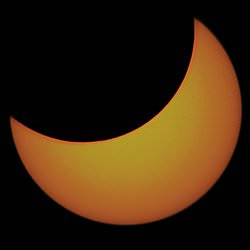
October 3rd annular eclipse from Belgium. Image credit: Christophe Bogaert. Click to enlarge.

Space and astronomy news

October 3rd annular eclipse from Belgium. Image credit: Christophe Bogaert. Click to enlarge.
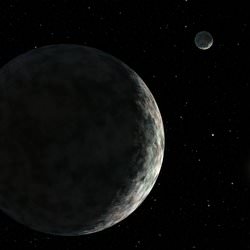
Artist illustration of the 10th planet and its moon. Image credit: Caltech. Click to enlarge.
The newly discovered 10th planet, 2003 UB313, is looking more and more like one of the solar system’s major players. It has the heft of a real planet (latest estimates put it at about 20 percent larger than Pluto), a catchy code name (Xena, after the TV warrior princess), and a Guinness Book-ish record of its own (at about 97 astronomical units-or 9 billion miles from the sun-it is the solar system’s farthest detected object). And, astronomers from the California Institute of Technology and their colleagues have now discovered, it has a moon.
The moon, 100 times fainter than Xena and orbiting the planet once every couple of weeks, was spotted on September 10, 2005, with the 10-meter Keck II telescope at the W.M. Keck Observatory in Hawaii by Michael E. Brown, professor of planetary astronomy, and his colleagues at Caltech, the Keck Observatory, Yale University, and the Gemini Observatory in Hawaii. The research was partly funded by NASA. A paper about the discovery was submitted on October 3 to Astrophysical Journal Letters.
“Since the day we discovered Xena, the big question has been whether or not it has a moon,” says Brown. “Having a moon is just inherently cool-and it is something that most self-respecting planets have, so it is good to see that this one does too.”
Brown estimates that the moon, nicknamed “Gabrielle”-after the fictional Xena’s fictional sidekick-is at least one-tenth of the size of Xena, which is thought to be about 2700 km in diameter (Pluto is 2274 km), and may be around 250 km across.
To know Gabrielle’s size more precisely, the researchers need to know the moon’s composition, which has not yet been determined. Most objects in the Kuiper Belt, the massive swath of miniplanets that stretches from beyond Neptune out into the distant fringes of the solar system, are about half rock and half water ice. Since a half-rock, half-ice surface reflects a fairly predictable amount of sunlight, a general estimate of the size of an object with that composition can be made. Very icy objects, however, reflect a lot more light, and so will appear brighter-and thus bigger-than similarly sized rocky objects.
Further observations of the moon with NASA’s Hubble Space Telescope, planned for November and December, will allow Brown and his colleagues to pin down Gabrielle’s exact orbit around Xena. With that data, they will be able to calculate Xena’s mass, using a formula first devised some 300 years ago by Isaac Newton.
“A combination of the distance of the moon from the planet and the speed it goes around the planet tells you very precisely what the mass of the planet is,” explains Brown. “If the planet is very massive, the moon will go around very fast; if it is less massive, the moon will travel more slowly. It is the only way we could ever measure the mass of Xena-because it has a moon.”
The researchers discovered Gabrielle using Keck II’s recently commissioned Laser Guide Star Adaptive Optics system. Adaptive optics is a technique that removes the blurring of atmospheric turbulence, creating images as sharp as would be obtained from space-based telescopes. The new laser guide star system allows researchers to create an artificial “star” by bouncing a laser beam off a layer of the atmosphere about 75 miles above the ground. Bright stars located near the object of interest are used as the reference point for the adaptive optics corrections. Since no bright stars are naturally found near Xena, adaptive optics imaging would have been impossible without the laser system.
“With Laser Guide Star Adaptive Optics, observers not only get more resolution, but the light from distant objects is concentrated over a much smaller area of the sky, making faint detections possible,” says Marcos van Dam, adaptive optics scientist at the W.M. Keck Observatory, and second author on the new paper.
The new system also allowed Brown and his colleagues to observe a small moon in January around 2003 EL61, code-named “Santa,” another large new Kuiper Belt object. No moon was spotted around 2005 FY9-or “Easterbunny”-the third of the three big Kuiper Belt objects recently discovered by Brown and his colleagues using the 48-inch Samuel Oschin Telescope at Palomar Observatory. But the presence of moons around three of the Kuiper Belt’s four largest objects-Xena, Santa, and Pluto-challenges conventional ideas about how worlds in this region of the solar system acquire satellites.
Previously, researchers believed that Kuiper Belt objects obtained moons through a process called gravitational capture, in which two formerly separate objects moved too close to one another and become entrapped in each other’s gravitational embrace. This was thought to be true of the Kuiper Belt’s small denizens-but not, however, of Pluto. Pluto’s massive, closely orbiting moon, Charon, broke off the planet billions of years ago, after it was smashed by another Kuiper Belt object. Xena’s and Santa’s moons appear best explained by a similar origin.
“Pluto once seemed a unique oddball at the fringe of the solar system,” Brown says. “But we now see that Xena, Pluto, and the others are part of a diverse family of large objects with similar characteristics, histories, and even moons, which together will teach us much more about the solar system than any single oddball ever would.”
Original Source: Caltech News Release
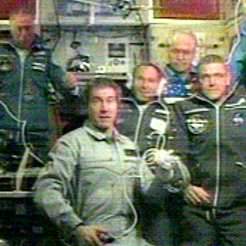
Greg Olsen and the crews of Expedition 11 and 12. Image credit: NASA. Click to enlarge.
The Soyuz spacecraft with the 12th international space station crew, Commander William McArthur and Flight Engineer Valery Tokarev, docked with the orbiting laboratory at 1:27 a.m. EDT Monday.
With them was American Greg Olsen, the third private citizen in space, flying under a contract with the Russian Federal Space Agency. He will spend about eight days on the station.
They launched from the Baikonur Cosmodrome in Kazakhstan just before midnight on Friday.
Olsen will conduct scientific experiments on the station, and then return to Earth with Expedition 11. That crew, Commander Sergei Krikalev and NASA Science Officer John Phillips, has been on the orbiting laboratory since April.
They will undock Oct. 10 in the Soyuz TMA that brought them to the station April 16. Landing is scheduled for 9:08 p.m. EDT that day in the steppes of Kazakhstan, winding up their 180-day increment.
McArthur, 54, a retired Army colonel, is a veteran of three shuttle flights, including one to the station and one to the Russian space station Mir. Tokarev, 52, a colonel in the Russian Air Force, is a veteran of one spaceflight, to the international space station aboard a space shuttle.
Hatches were opened at 4:36 a.m. EDT. After hugs and greetings with the traditional bread and salt, they got a safety briefing from the Expedition 11 crew. In extensive handover briefings during their eight days together, they will get training on systems and experiments on the station and on the Canadarm2 robotic arm.
During their six months on the station McArthur and Tokarev will do two or three spacewalks. The first, from the Quest airlock in U.S. spacesuits, is planned for early November. Tasks include installation of a camera group and retrieval of the station’s floating potential probe.
That will be McArthur’s third spacewalk and the first for Tokarev.
About two weeks later the crewmembers will board their Soyuz spacecraft and move it from the Pirs docking compartment to a docking port on the Zarya module. That will clear the Pirs for use of its airlock in a spacewalk using Russian Orlan suits in December.
That spacewalk will focus on retrieving scientific experiments and photography of a micrometeoroid monitoring system and the Soyuz descent module’s multilayer insulation.
A third spacewalk early next year in U.S. spacesuits is under consideration.
McArthur and Tokarev also are scheduled to welcome an unpiloted Progress cargo craft to the station, just in time for Christmas. That Progress will bring fuel, equipment, supplies, water, oxygen and air to the station. Docking is planned for Dec. 23.
Station maintenance will occupy considerable time. They will continue scientific investigations aboard the orbiting laboratory, as well as a program of scientific education activities and Earth observations.
Their replacements, the 13th crew of the station, are scheduled to arrive in March.
Original Source: NASA News Release
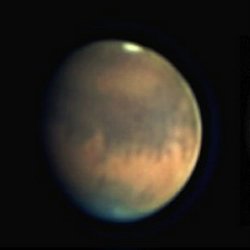
Mars. Image credit: Efrain Morales. Click to enlarge.

Scientist now accept that the cosmic microwave background (CMB) radiation results from the big bang. This knowledge was slow in developing. In 1920, Shapley and Curtis debated whether the universe is bigger than the Milky Way Galaxy. Yet, pieces of the puzzle kept falling into place, such as the red-shift indicating an expanding universe. However, we knew by then that mass attracts, so why are stars moving away? For resolution, Einstein introduced a cosmological constant (which he later refuted). The accidental discovery of the CMB in 1964 firmly set the stage for the inflationary theory of the universe, yet knowing its existence wasn’t enough. To delve deeper, NASA first sponsored COBE (from 1976 to 1991) then picked WMAP to “drive down the margin of error and nail down the physical characteristics…expansion rate, geometry, matter density, matter to dark matter ratio…”. Thus cosmology follows the typical tale of scientific advancement; the piecing together of little clues to develop an overarching paradigm.
The technical information that relates to the CMB is humongous. This book is not. Lemonick chooses to go the route of simplicity in conveying the scientific details. For the most part, references come with minimal description. For example, the reader is left to wonder about the relative worth of HEMT’s (high electron mobility transistors) to bolometres as the electronic detector of choice. Or for another, we read of omega, the mass/energy density that relates to dark matter and dark energy and to the shape of the universe. There are some standard descriptions, such as of topology and its doughnuts, but that is all. As cosmology combines the skills of many disciplines, this level of detail is necessary for this size book.
Rather than concentrating on the technical aspects, Lemonick emphasises the people. This is sensible as Lemonick is not a cosmological theoretician, he is a broadsheet science writer. Using a mostly chronological ordering, he presents the prerequisite characters of WMAP and many of the COBE mission as well. We read of anxiety in building the satellite, preoccupation leading to gallbladder surgery, and sleepless nights necessary for processing data. By nicely adding emotion to the description of the scientists, Lemonick puts in a real human flavour. This lightens the topic, but if you’re not interested in the side details, such as procurement strategies for high end electronics, this can be a bit off putting.
Further, continual side steps into this trivia or some person’s characteristic traits makes this book hard to classify. At times, it seems quite eloquent, such as the setting described as “…after a mild winter, the brilliance of the campus in full bloom is almost overwhelming”. This same style relates to system testing where the satellite is “…plunged down to extreme cold, vibrated, bombarded with simulate microwave signals, blasted with sound waves from gigantic loudspeakers four feet across”. With these, the reading is simple but the overall sense is of a smooth series of factoids presented one after the other. Once finished, the reader should feel quite prepared for a game of Trivial Pursuit, the Cosmology Edition (if it exists).
If you’re looking for a well written, entertaining science book that is easy to pick up and put down, this is it. There’s enough substance to keep you interested while sitting on the bus commuting into work. However, there’s not enough to over embellish the lore of cosmology, the established traits of the pertinent scientists or typify the build out of scientific satellites. A clearer title or a clarifying sub title would have been helpful.
Well, how much are discoveries worth? A satellite can answer fundamental questions about our existence, but only if we want to pay the piper. The WMAP mission was such a story as with a ceiling cost, it successfully answered specific cosmologic questions. Michael Lemonick in his book Echo of the Big Bang brings to us the story of this mission, the people involved and the challenges of high-end electronics. In combining a sense of history with the warmth of personalities he gives the average person a great introduction into cosmology and high end science.
Review by Mark Mortimer
Read more reviews online, or purchase a copy from Amazon.com.
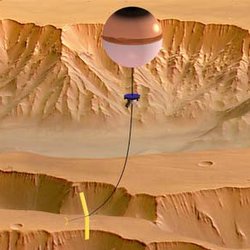
Artist illustration of a balloon floating above Mars. Image credit: ESA/Global Aerospace. Click to enlarge.
Mars rovers, Spirit and Opportunity, have, by now, spent almost two years on the surface of Mars. They traveled several miles each, frequently stopping and analyzing scientific targets with their cameras, spectrometers and other instruments to uncover evidence of liquid water on Mars in the past. Their mission is a smashing success for NASA.
But what if NASA had a platform on Mars that was able to cover these distances in a matter of hours instead and study the rocks on the surface in the same detail as rovers do? Scientific return from such a vehicle would be immense scientists would be able to study the whole planet in greater detail in a time span of a single year.
While orbiters can look at virtually any point on the surface of a planet, they lack the resolution provided by instruments on rovers or landers. Rovers, on the other hand, have limited mobility and cannot travel very far from their landing site. As the atmosphere of Mars is very thin, an airplane at Mars would last for just an hour until it runs out of fuel.
Global Aerospace Corporation of Altadena, CA proposes that the Mars exploration vehicle combining the global reach similar to that of orbiters and high resolution observations enabled by rovers could be a balloon that can be steered in the right direction and that would drop small science packages over the target sites. The concept being developed by the Global Aerospace Corporation is funded by the NASA Institute for Advanced Concepts (NIAC).
Balloons have been long recognized as unique, scientific platforms due to their relatively low cost and low power consumption. Two balloons flew in the atmosphere of Venus in 1984. In the past the inability to control the path of Mars balloons has limited their usefulness, and therefore scientific interest in their use.
Global Aerospace Corporation has designed an innovative device, called Balloon Guidance System (BGS) that enables steering a balloon through the atmosphere. The BGS is an aerodynamic surface a wing that hangs on a several kilometer-long tether below the balloon. The difference in winds at different altitudes create a relative wind at the latitude of the BGS wing, which in turn creates a lifting force. This lifting force is directed sideways and can be used to pull the balloon left or right relative to the prevailing winds.
Floating just several kilometers above the surface of Mars, the guided Mars balloons can observe rock formations, layerings in canyon walls and polar caps, and other features at very high resolution using relatively small cameras. They can be directed to fly over specific targets identified from orbital images and to deliver small surface laboratories, that will analyze the site at the level of detail rovers would do. Instruments at the balloon’s gondola can also measure traces of methane in the atmospheric and follow its increasing concentrations to the source on the ground. This way the search for existing or extinct life on Mars can be accelerated.
Original Source: NASA Astrobiology
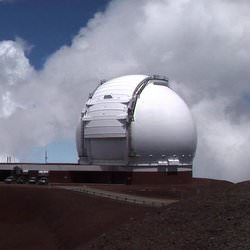
The massive Keck telescope on Hawaii’s Mauna Kea. Image credit: NASA/JPL. Click to enlarge.
Are we alone in the universe? Are there planets like Earth around other ?suns? that might harbor life? Thanks to a recent technology breakthrough on a key NASA planet-finding project, the dream of answering those questions is no longer light-years away.
On a crystal clear, star-filled night at Hawaii?s Keck Observatory in Mauna Kea, NASA engineers successfully suppressed the blinding light of three stars, including the well-known Vega, by 100 times. This breakthrough will enable scientists to detect the dim dust disks around stars, where planets might be forming. Normally the disks are obscured by the glare of the starlight.
Engineers accomplished this challenging feat with the Keck Interferometer, which links the observatory?s two 10-meter (33-feet) telescopes. By combining light from the telescopes, the Keck Interferometer has a resolving power equivalent to a football-field sized telescope. The ?technological touchdown? of blocking starlight was achieved by adding an instrument called a ?nuller.?
This setup may eventually help scientists select targets for NASA?s envisioned Terrestrial Planet Finder missions. The success of those potential future missions, one observing in visible light and one in infrared, depends on being able to find Earth-like planets in the dust rings around stars.
?We have proven that the Keck Interferometer can block light from nearby stars, which will allow us to survey the amount of dust around them,? said Dr. James Fanson, project manager for the Keck Interferometer at NASA’s Jet Propulsion Laboratory. That survey will begin in late 2006 after the team refines the nuller?s sensitivity level.
Combined information from all of NASA?s planet-hunting missions will provide a complete picture of possible Earth-like planets: how big they are, whether they are warm enough for life, and if their atmospheres and surfaces show chemical signatures of current life.
?People have been talking about whether there are other earths out there for 2,500 years. Only now are we developing the technology to go find out,? said Michael Devirian, manager of NASA?s Navigator Program at JPL, which is investigating potential planet-exploring missions.
So far, scientists around the world have found 150 planets orbiting other stars. Most are giants, like Jupiter; none is as small as Earth. Scientists believe the best odds of finding life outside our solar system are on Earth-sized planets, particularly those with the right temperature, density and chemistry.
More information on NASA?s planet-finding missions, including the Keck Interferometer and Terrestrial Planet Finder is at http://planetquest.jpl.nasa.gov.
JPL manages the Keck Interferometer and the Terrestrial Planet Finder missions for NASA?s Science Mission Directorate, Washington. JPL is a division of the California Institute of Technology in Pasadena. The W.M. Keck Observatory is funded by California Institute of Technology, the University of California and NASA, and is managed by the California Association for Research in Astronomy, Kamuela, Hawaii.
Original Source: NASA/JPL News Release
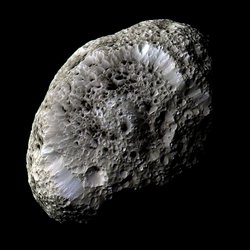
Saturn’s moon Hyperion. Image credit: NASA/JPL/SSI. Click to enlarge.
Cassini performed back-to-back flybys of Saturn moons Tethys and Hyperion last weekend, coming closer than ever before to each of them. Tethys has a scarred, ancient surface, while Hyperion is a strange, spongy-looking body with dark-floored craters that speckle its surface.
New images, mosaics and a movie of these bodies are available at http://saturn.jpl.nasa.gov , http://www.nasa.gov/cassini and http://ciclops.org .
Images of Tethys taken during Cassini’s close approach to the moon on Sept. 24, 2005, reveal an icy land of steep cliffs and craters. Cassini photographed the moon’s south pole, a region not seen by NASA’s Voyager spacecraft.
A giant rift called Ithaca Chasma cuts across the disk of Tethys. Much of the topography in this region, including that of Ithaca Chasma, has been thoroughly hammered by impacts. This appearance suggests that the event that created Ithaca Chasma happened very long ago.
Near a prominent peaked crater named Telemachus are the remnants of a very old crater named Teiresias. The ancient impact site is badly overprinted and eroded by impact weathering and degradation. All that remains is a circular pattern of hummocks that mark where the old crater rim existed. Many of the fresh-appearing craters exhibit unusually bright crater floors, in contrast to the dark-floored craters seen on Saturn’s oddly tumbling moon Hyperion.
Images of Hyperion taken on Sept. 26 show a surface dotted with craters and modified by some process, not yet understood, to create a strange, “spongy” appearance, unlike the surface of any other Saturn moon.
A false-color image of Hyperion reveals crisp details and variations in color across the strange surface that might represent differences in the composition of materials. Hyperion has a notably reddish tint when viewed in natural color.
Scientists are extremely curious to learn what the dark material is that fills many craters on this moon. Features within the dark terrain, including a 200-meter-wide (650-feet) impact crater surrounded by rays and numerous bright-rimmed craters, indicate that the dark material may be only tens of meters thick with brighter material beneath.
Scientists will also be examining Cassini’s sharp views in hopes of determining whether there have been multiple episodes of landslides on Hyperion. Such “downslope” movement is evident in the filling of craters with debris and the near elimination of many craters along the steeper slopes. Answers to these questions may help solve the mystery of why this object has evolved different surface forms from other moons of Saturn.
Cassini flew by Hyperion at a distance of only 500 kilometers (310 miles). Hyperion is 266 kilometers (165 miles) across, has an irregular shape, and spins in a chaotic rotation. Much of its interior is empty space, explaining why scientists call Hyperion a rubble-pile moon. This flyby was Cassini’s only close encounter with Hyperion in the prime mission four-year tour. Over the next few months, scientists will study the data in more detail.
Cassini flew by Tethys at a distance of approximately 1,500 kilometers (930 miles) above the surface. Tethys is 1,071 kilometers (665 miles) across and will be visited again by Cassini in the summer of 2007.
The Cassini-Huygens mission is a cooperative project of NASA, the European Space Agency and the Italian Space Agency. The Jet Propulsion Laboratory, a division of the California Institute of Technology in Pasadena, manages the Cassini-Huygens mission for NASA’s Science Mission Directorate, Washington, D.C. The Cassini orbiter and its two onboard cameras were designed, developed and assembled at JPL. The imaging team is based at the Space Science Institute, Boulder, Colo.
Original Source: NASA/JPL/SSI News Release
“Snowball Earth” proponents, who say that Earth’s oceans were long ago covered by thick ice, explain the survival of life by hypothesizing the existence of small warm spots, or refugia. On the other side, supporters of a “Slushball Earth” say the planet included large areas of thin ice or open ocean, particularly around the equator.
Now, scientists who applied innovative techniques to previously unexamined rock formations have turned up strong evidence to support the “Slushball Earth” side of the decades-long scientific debate.
The study appears in the Sept. 29 online Science Express
The debate has tended to revolve around the same rock samples and analytical techniques, said Alison Olcott, an earth scientist at the University of Southern California. So she and her team focused on a drill core of little-known black shale deposits from southeastern Brazil and applied lipid biomarker techniques to identify prehistoric organisms based on the fatty remains of their cell membranes.
“This evidence for life in parts of the global oceans requires a revision of our interpretations related to this period of low-latitude glaciation,” said Enriqueta Barrera, program director in the National Science Foundation’s (NSF) Division of Earth Sciences, which funded the research.
The team, which included scientists from USC, Caltech, the University of Maryland and a Brazilian mining company, identified a complex and productive microbial ecosystem, including photosynthesizing organisms that could not have existed under a thick layer of ice.
“If there were ice, it had to have been thin enough that organisms could photosynthesize below it or within it,” Olcott said.
Frank Corsetti of USC, a co-author on the study, said “this is the first real evidence that substantial photosynthesis occurred in the Earth’s oceans during the extreme ice age 700 million years ago, which is a challenge for the snowball theory.”
The evidence does not prove large parts of the ocean remained free of sheet ice during the pre-Cambrian glaciation. Although unlikely, Olcott said it is possible one of the tiny “refugia” under the “Snowball Earth” hypothesis allowed such marine life to exist.
But, she said, “finding the one anomalous spot would be quite unlikely,” adding that the samples she studied came from an extensive formation of rocks with similar characteristics.
“At what point does an enormous refugium become open ocean?” she asked.
Skeptics also may argue that the rocks do not necessarily date to a glacial era, Olcott said. But the team found evidence of glacial activity in the samples, such as dropstones (continental rocks dropped by melting glaciers into marine deposits) and glendonites (minerals that only form in near-freezing water).
“Geologists don’t necessarily think of looking for traces of microbes left in the rocks. This is the first direct look at the ecosystem during this time period,” said Olcott, who credited USC’s geobiology program, one of a handful in the country, with influencing her thinking.
Original Source: NSF News Release

Spiral Galaxy NGC 1350. Image credit: ESO. Click to enlarge.
Eighty-five million years ago on small planet Earth, dinosaurs ruled, ignorant of their soon-to-come demise in the great Jurassic extinction, while mammals were still small and shy creatures. The southern Andes of Bolivia, Chile, and Argentina were not yet formed and South America was still an island continent.
Eighty-five million years ago, our Sun and its solar system was 60,000 light years away from where it now stands [1].
Eighty-five million years ago, in another corner of the Universe, light left the beautiful spiral galaxy NGC 1350, for a journey across the universe. Part of this light was recorded at the beginning of the year 2000 AD by ESO’s Very Large Telescope, located on the 2,600m high Cerro Paranal in the Chilean Andes on planet Earth.
Astronomers classify NGC 1350 as an Sa(r) type galaxy, meaning it is a spiral with large central regions. In fact, NGC 1350 lies at the border between the broken-ring spiral type and a grand design spiral with two major outer arms. It is about 130,000 light-years across and, hence, is slightly larger than our Milky Way.
The rather faint and graceful outer arms originate at the inner main ring and can be traced for almost half a circle when they each meet the opposite arm, giving the impression of completing a second outer ring, the “eye”. The arms are given a blue tint as a result of the presence of very young and massive stars. The amount of dust, seen as small fragmented dust spirals in the central part of the galaxy and producing a fine tapestry that bear resemblance with blood vessels in the eye, is also a signature of the formation of stars.
The outer parts of the galaxy are so tenuous that many background galaxies can be seen shining through them, providing the observers with an awesome sense of depth. It is indeed quite remarkable to see that with a total exposure time of only 16 minutes, the VLT lets us admire such an incredible collection of island universes wandering about in the sky. ESO PR Photo 31b/05 is a mosaic of some of the most prominent galaxies found in the images. Some of these may reside as far as several billion light-years away, i.e. the light from these galaxies was emitted when the Sun and the Earth had not yet formed.
NGC 1350 is located in the rather inconspicuous southern Fornax (The Furnace) constellation [2]. Recessing from us at a speed of 1860 km/s [3], it is eighty-five million light-years away. It is thus most probably not a member of the Fornax cluster of galaxies, the most notable entity in the constellation, that lies about 65 million light-years away and contains the much more famous barred spiral NGC 1365. On the sky, NGC 1350 stands on the outskirts of the Fornax cluster as can be seen on this image taken with the 1m-Schmidt telescope at La Silla.
Original Source: ESO News Release